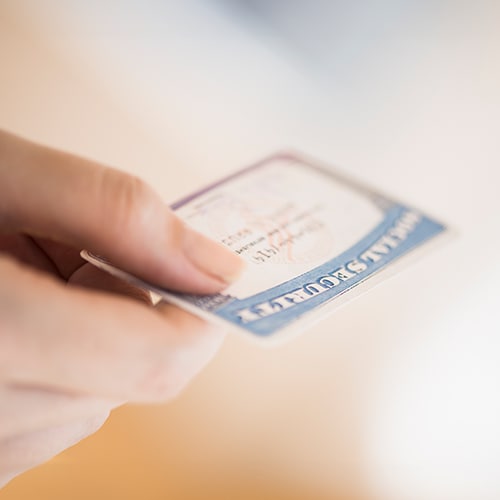- Phishing emails pretending to be from the IRS, tricking victims into giving up personal information.
- Fake tax preparers who steal financial details under the guise of helping you file.
- Data breaches that expose SSNs and financial records, making it easier for scammers to file fraudulent returns.
Tax identity theft happens when a scammer files a fraudulent tax return using your Social Security number (SSN) and personal information to claim a refund. You often don’t realize it’s happened until you try to file your taxes, only to receive an IRS notice that your return has already been submitted.
Common tax scam tactics:
- Phishing emails pretending to be from the IRS, tricking victims into giving up personal information.
- Fake tax preparers who steal financial details under the guise of helping you file.
- Data breaches that expose SSNs and financial records, making it easier for scammers to file fraudulent returns.
How to confirm if your tax refund has been stolen
If your tax refund hasn’t arrived, it could be delayed—or it could be stolen. The IRS processes millions of returns each tax season, and various factors can slow things down, including errors on your return, incomplete information, or an influx of filings during peak times. Additionally, if the IRS suspects fraud, they may hold your refund for further review, which can add weeks or even months to the process. Here is how to confirm if your tax refund has been stolen:
- Check your IRS account to see if your return has been processed.
- Use the “Where’s My Refund” tool on IRS.gov to track your refund status.
- Call the IRS at 1-800-829-1040 to ask about the status of your return.
- Consult your tax preparer if you used one, as they may have insight into the delay.
What to do if someone steals your tax refund
If you confirm that your refund has been stolen, act fast to limit the damage.
- Request a refund trace. Contact the IRS to initiate a refund trace, which helps determine if your check was cashed fraudulently.
- Report identity theft to the IRS. File IRS Form 14039 (Identity Theft Affidavit) to alert the agency to fraud.
- Freeze your credit. Place a credit freeze with all three major credit bureaus (Experian, Equifax, and TransUnion) to prevent further fraud.
- Notify your bank. If your direct deposit was stolen, your bank may be able to help recover funds.
- Monitor your financial accounts. Watch for suspicious activity in your bank and credit card statements.
- Sign up for identity theft protection. A protection service can alert you to future identity fraud attempts in other places and help monitor your credit.
How to help protect yourself from tax fraud and identity theft
While you can’t always prevent tax fraud, and identity theft, you can take steps to make it much harder for scammers to target you.
Request an Identity Protection (IP) PIN
An IP PIN is a six-digit code the IRS assigns to taxpayers to verify their identity when filing returns. Without it, scammers can’t file taxes in your name. You can request an IP PIN at IRS.gov.
Use unique passwords for all online accounts
Reusing passwords makes it easy for hackers to access your financial accounts. Use a password manager to generate and store unique passwords for every account.
Sign up for identity theft protection
Identity theft protection services monitor your personal information, alerting you to suspicious activity. LifeLock offers:
- SSN monitoring to detect if your SSN is being used fraudulently.
- Credit monitoring for early detection of financial fraud.
- Fraud resolution support to help you recover stolen funds.
Tax refund fraud is frustrating, but with the right steps, you can recover your money and help protect yourself from future scams. If you’re looking for more ways to help secure your identity year-round, join LifeLock for features that can help you monitor identity theft risks.
FAQs
What happens if someone steals your IRS refund?
If a fraudster claims your refund, you’ll need to file an Identity Theft Affidavit (Form 14039) with the IRS and request a refund trace to recover your money.
What can you do if someone files a tax return in your name?
You should report the fraud to the IRS immediately, file Form 14039, and request an IP PIN to prevent future fraudulent filings.
How do you know if someone used your Social Security number (SSN) to file a tax return?
If your return is rejected due to a duplicate filing, or if the IRS sends you a notice about a suspicious return, it’s likely your SSN was used fraudulently.
What happens if you lose your tax refund check?
You can request a replacement check from the IRS by filing Form 3911 (Taxpayer Statement Regarding Refund).
Common tax scam tactics:
- Fake tax preparers who steal financial details under the guise of helping you file.
Editor’s note: Our articles provide educational information. LifeLock offerings may not cover or protect against every type of crime, fraud, or threat we write about.
Related articles
Start your protection,
enroll in minutes.
LifeLock is part of Gen – a global company with a family of trusted brands.
Copyright © 2025 Gen Digital Inc. All rights reserved. Gen trademarks or registered trademarks are property of Gen Digital Inc. or its affiliates. Firefox is a trademark of Mozilla Foundation. Android, Google Chrome, Google Play and the Google Play logo are trademarks of Google, LLC. Mac, iPhone, iPad, Apple and the Apple logo are trademarks of Apple Inc., registered in the U.S. and other countries. App Store is a service mark of Apple Inc. Alexa and all related logos are trademarks of Amazon.com, Inc. or its affiliates. Microsoft and the Window logo are trademarks of Microsoft Corporation in the U.S. and other countries. The Android robot is reproduced or modified from work created and shared by Google and used according to terms described in the Creative Commons 3.0 Attribution License. Other names may be trademarks of their respective owners.





